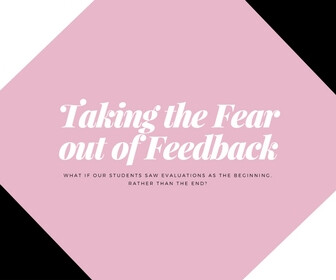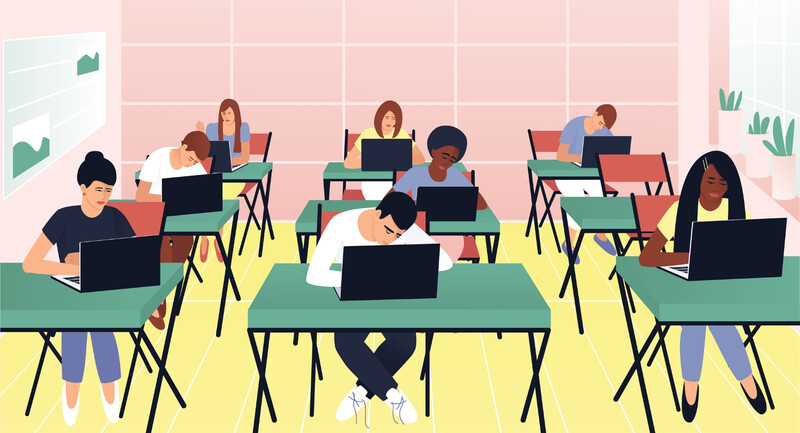We’ve all had it happen.
We sacrifice hours toiling away at our desks and on sofas in our living rooms, pouring our hearts, our knowledge, onto student work, trying to strike just the right balance of criticism and encouragement. The day has come, and as we pass back their assignments, we wait to hear the hush of busy minds and shuffling of papers as they read through our thoughtful words. Instead we hear, “What did you get?” “Aww man!” [crumple-crumple] and watch as the paper balls sail toward the trash.
All that work… all that time…
But the real frustration should not be with their apathy. Can we really expect a room full of teenagers who are still learning that they have flaws to care about how to fix them?
First we need to understand the nature of teenagers and their views of criticism. Adolescence is a critical time in development that alters the way teenagers view the world. They are experiencing things for the first time and have elevated levels of hormones that cause seemingly irrational responses. They are more likely to become embarrassed from even the smallest teasing, leading them to fear the very situations that are necessary for learning (Prickhardt, 2013). Studies show that the experiences teenagers face can change their brain chemistry, leading to higher risk of mental illness that could extend into adulthood (Burgland, 2013). So, the feedback we want to provide could actually do more damage than good if not received appropriately.
Therefore, before changing how we give feedback, it is imperative that we change the learning mindset. Most students see failure as a negative judgement and believe that evaluations in the learning process compare them to their peers and calculate potential. They are right. In the current culture of standardized tests and data-driven evaluation, students are judged based on their performance. We knowingly ask students to enjoy confronting their worst fears of inadequacy every day. Not many adults could handle that pressure.
But what if our students saw evaluations as the beginning, rather than the end? What if they looked forward to criticism because they saw it as valuable? What if it was a snapshot of where they are, and not what they are capable of becoming?
Tell students why they are doing this work, about how their brains grow, and the messy truth about learning. Model learning, acceptance of criticism, and how to be vulnerable. Create an environment that accepts failures and encourages growth, even in our most insecure learners. We can achieve this through systematic and student-friendly feedback.
Criteria for an Effective Feedback System
When developing an effective feedback system, it is important to consider what our students are developmentally ready for and make sure that we have clear and appropriate targets that students know. We must use continuous feedback to convey mastery at various points throughout the learning process. Above all, feedback should be:
- Simple & student friendly: Often, all those comments/criticisms we write and discuss are lost because students become overwhelmed. The most important aspect of feedback is student accessibility. “Feedback–no matter how well designed–that the student does not act upon is a waste of time” (Wiliam & Leahy, 2015). Students need to know whether they have mastered, partially mastered, or not mastered the material and what to do next. If students can’t understand it, they won’t be able to use it.
- Consistent: Along with simplicity, feedback must be consistent. It should look the same every time students encounter it with few variations. Students will only feel comfortable and confident with a system they see daily and use with every assignment. With repetition and practice, students will begin to recognize patterns in their own and others’ work, leading them to become effective feedback-givers themselves.
- Based on symbols & codes, not letters or numbers: If we want students to focus on their learning and set appropriate goals for themselves, we cannot put a grade on everything they do. Students must be permitted to make mistakes and take risks as they learn. Using a system of symbols and codes to direct students to areas of concern and resources for improvement changes the conversation. Instead of asking about their grades, we begin to hear questions like, “Have you mastered this yet?” and “What do I need to fix to improve?” It reinforces to that there is a next step in their learning process and that they still have the potential to be successful in the future.
Student Use and Teacher Management of Feedback
Instead of the grumbling-and-crumpling on the day we pass back assignments, we want to see our students self-reflecting and engaging in meaningful conversations about where they are and what they need to do next. Our system of symbols should both provide the “You are Here” location on the map of student learning while at the same time highlighting potential paths toward their ultimate destination. These next steps need to be explicit and expected.
With so many different actions and possibilities, feedback can seem like an overwhelming task for the teacher. Since we don’t have enough time in class, we resort to writing EVERYTHING down on assignments, hoping the students will internalize it. This works against us in a few ways. First, feedback should occur as soon as possible in the learning process. Second, feedback is best when provided face-to-face to allow for direct reteaching as necessary. But HOW?
We are not the only ones capable of facilitating learning. Studies suggest that students actually learn more from peer feedback since they are more likely to act on peers’ suggestions (Wiliam & Leahy, 2015, p. 144). Since feedback highlights strengths and weaknesses, it makes sense for students to take an active role in each others’ learning. Learning is not a chauffeured experience, but rather a journey of winding trails with unlimited possibilities and encounters. Our students need to experience both navigating and guiding these trails together.
In order to use student feedback effectively, we must make sure that students are confident in giving effective feedback. They need to know not only what the feedback system means, but also how it is determined. They need to practice providing criticism using clear and consistent rubrics with sentence starters and checklists. Lastly, they need to feel safe in both giving and receiving feedback from each other by knowing how unpredictable it can be and how to ask for help without feeling embarrassed or powerless.
Let’s take the fear out of feedback and turn apathy into opportunity!








